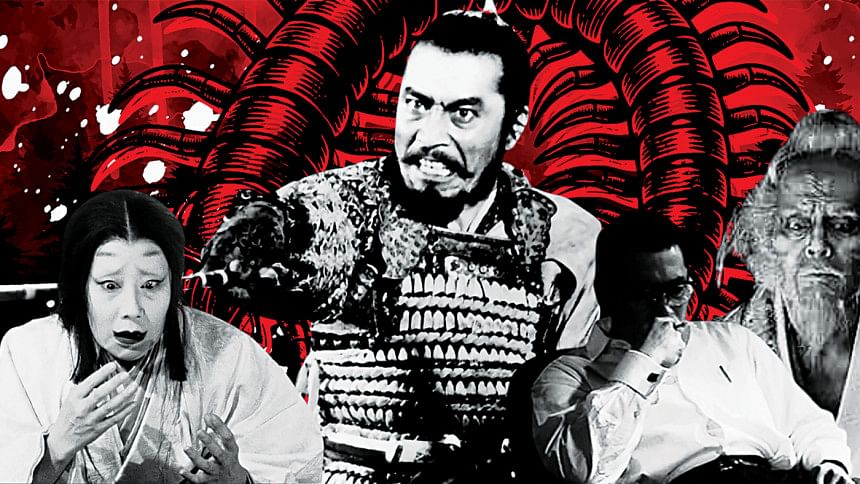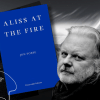Human passions in Kurosawa’s Shakespeare

Shakespeare's enduring international appeal is in part due to the remarkable personalities he had invented. The bulbous, comic Falstaff, the cruel Edmund and crueller Iago, the acceleratingly ambitious Macbeth and, of course, the charismatic Prince of Denmark himself—they stay relevant, unchanged in spirit through their journeys of translation, at least in the films and plays in South Asia that I am aware of. In Akira Kurosawa's three films based on Shakespeare plays, the Japanese maestro tones down this very remarkable aspect of Shakespeare. He plays around instead with the unforgettable emotions that the Bard's plays gift us.
If we look at the precise moment in Kurosawa's Throne of Blood (1957) when the generals Washizu and Miki (personifying Macbeth and Banquo, respectively) meet an evil spirit who reveals what the future holds for them and return to their Lord's castle to learn that the spirit's words are coming true, we see a sense of shock in the characters' faces as they move toward the camera. It is not merely shock but shock coupled with pleasure. A revelatory sequence transformed into a feeling of terror for the audience as the characters slowly approach them. This is not present in the play, where Macbeth learns the first prophecy had come true from a nobleman having arrived to congratulate him of their victory against Norway and Ireland. It is a small invention, but one that showers a sense of dread and intrigue in the film. The audience gets a second stab of this terror through Washizu's wife, the Lady Asaji Washizu. She may not have the dominating presence of Lady Macbeth, but her trembling fingers as she tries to wash the "blood" off her fingers is as strikingly affecting as it is in the play itself.
Kurosawa's take on the Scottish play interestingly eschews the need for the character of Macduff—a puzzling decision in my view. I feel, undoubtedly like many others, that Macbeth without Macduff is meaningless and Kurosawa's choice to forego his part is curiously provocative in a way, divorcing Macbeth from one of the prophecies that brings his end.
But as one sees in Kurosawa's next venture with Shakespeare, The Bad Sleep Well (1960), he is not interested in either the plot or the character but in dismantling the emotions of these timeless tales and refashioning them on the screen. A noir take on Hamlet, The Bad Sleep Well least resembles the play and is rather a marriage of varied passions: the son intending to avenge his father, the hotheaded brother's desire to protect his sister, the paranoia regarding sanity, the acting within acting, the ghosts which materialise to offer grievances. In many ways, Kurosawa's film is exactly how an adaptation of Hamlet should be: vast, multi-faceted, going beyond the worldly headaches to focus on what it means to be human. Just as in Hamlet, one barely ever worries over Fortinbras' invasion, in The Bad Sleep Well, the worrying over bribes and corrupt kickback schemes of the company in question are only background wind. It is the trammeled lives of the characters, the outpouring of their charges that shakes the audience to their core.
More than two decades later, in 1985, Kurosawa's third Shakespeare film Ran was released. Based on King Lear, it is one of his supreme achievements. So magnificent is its violence, so intricately embroidered is the envy, shame, and evil of the characters that the film becomes something much larger than a war epic. Many of Shakespeare's international translations are vessels. The punk mafioso Romeo+Juliet (1996) is still Romeo and Juliet when you throw out the suits and guns. A tepid version of Hamlet can easily be squeezed out of The Lion King (1994). I would even admit Throne of Blood, regardless of its beauty, is a vessel from which you can easily chop out the "real" Macbeth. That is not possible with Ran. So original it is and yet so intertwined with King Lear, one cannot even begin to explain how Kurosawa managed to bring this into existence.
I confess to never being impressed with Edmund, the principal antagonist in King Lear. He is no Iago. But in Ran, Kurosawa rebirths him as Lady Kaede, the wife of the eldest of the three sons. In Lady Kaede, Edmund is finally fitted with a personality that is justifiable. Indeed, Lady Kaede's cruelty is a cinematic marvel. Kurosawa's King Lear is patently a man's world. The three daughters of King Lear are turned into the three sons of the ageing samurai, Hidetora. But it is Lady Kaede who shines bright amidst (or perhaps, because of) the carnage and slaughter all over the Kingdoms.
Akira Kurosawa's adaptations of Shakespeare's three great tragedies will outlive us all, especially Ran. The films celebrate what truly makes Shakespeare great: the passions of humanity. The speeding, destructive ambition of Washizu as Macbeth, the bottled up rage of Koichi Nishi as Hamlet, Lady Kaede's chaotic orchestrations of violence and seductions as Edmund. I often wonder what a Kurosawa adaptation of the bard's fourth great tragedy, Othello, would have been. How would he have, for instance, constructed Iago for the screen? One could only rest easy knowing that whatever he'd do, Kurosawa could never serve us Shakespeare at room temperature.
Shahriar Shaams has written for Dhaka Tribune, The Business Standard, and The Daily Star. He can be emailed at [email protected]. Find him on X: @shahriarshaams.

 For all latest news, follow The Daily Star's Google News channel.
For all latest news, follow The Daily Star's Google News channel. 










Comments